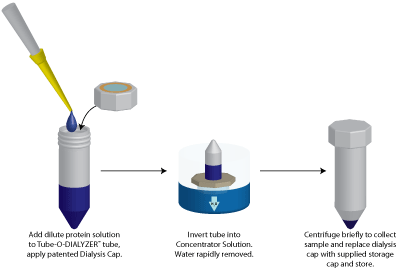Question
I am needing a product to concentrate 20mg of protein. My current volume is 15mL and I need to get to under 5mL volume. I have used spin columns in the past and my protein has gotten stuck on the cellulose membrane, so I am looking for alternatives.
The Protein Man Says:
Protein Concentration is an important step in protein extraction and purification. The large amount of starting material used to acquire an adequate quantity of a protein of interest results in large volumes of dilute protein. Following protein extraction, the purified proteins need to be concentrated.
Several methods exist for protein concentration.
Cellulose Membrane Concentrators
As stated in the question a routinely used method are protein concentrators that contain a cellulose membrane. The dilute protein sample is loaded into the concentrator and a centrifugal force applied. The solvent and small molecules pass through the cellulose membrane and retains the proteins. As stated above an inherent problem is the proteins interacting with the membrane.
Dialysis
A similar approach is to use a dialysis technique. The dilute protein solution is placed in a dialysis bag or alternative dialysis device, such as Tube-O-DIALYZER, and the sample is dialyzed against a water absorbing polymer. The dialysis membrane retains the proteins inside the dialysis bag or device and the sample is concentrated as the water is pulled across the dialysis membrane. An ideal water absorbing polymer would be polyethylene glycol. G-Biosciences offers both a Concentrator Solution and a Concentrator Powder for this purpose. Our Tube-O-Concentrator contains the liquid concentrator and dialysis devices for added convenience.

Precipitation or Salting Out
Precipitation of proteins is a routinely used technique for concentrating proteins as it is simple to use with large sample volumes.
The basic method is to use "Salting-Out", which is normal performed with ammonium sulfate. The increasing concentrations of ammonium sulfate leads to an increase in ionic strength of the solution. Increasing ionic strength results in:
- Reduction in Repulsion of Same Charges of Protein Molecules
- Reduces Forces Holding Solvation Shell Around Proteins
Once these forces are sufficiently reduced the proteins will interact and precipitate. The precipitated proteins can be collected by centrifugation and be resolubilized in a smaller volume to concentrate. One side effect of salting out is that the high salts may disrupt the biological structure and activity of the proteins and this may not return on resolubilization.
G-Biosciences offers UPPA-PROTEIN-Concentrate that is contains a proprietary precipitation reagent to precipitate proteins and solubilization buffers to resolubilize the proteins of interest. Precipitation may also be performed with a organic solvent and this protects the biological activity of protein, more than salting out. Our Orgosol-PROTEIN-Concentrate kit uses this principal.
Chromatography
A final option for protein concentration is to use some form of affinity chromatography. For example, if the protein of interest has a tag, such as a 6X His, than it can be concentrated by immobilized metal affinity chromatography.
The chromatography method is dependent on some knowledge of the protein and using a suitable affinity column.
G-Biosciences Column-PROTEIN-Concentrate use a protein affinity resin to purify proteins from a large volume.
The Protein Man Review
- Several methods available, including the use of membranes, salting out or chromatography
- Choice dependent on volume size and downstream applications






